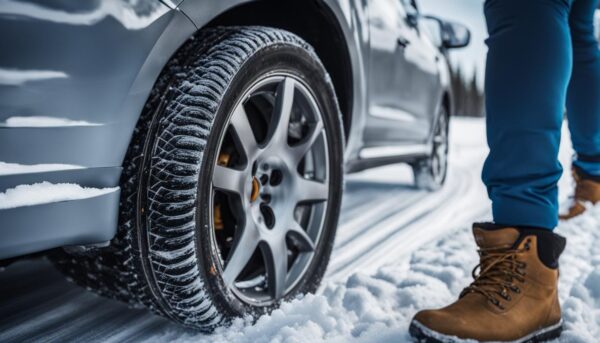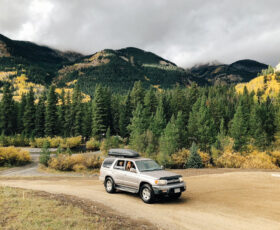Last Updated on 4 months
Choosing the Right Tires for Winter Driving Excellence
When it comes to tire safety and driving experience, choosing the right tires for your vehicle is of utmost importance. With multiple options on the market, it’s essential to understand different tire types and their intended usage clearly. The comparison between winter tires and all-season tires can be incredibly confusing. In this guide, we will cover crucial information on the differing characteristics of these two popular tire choices so you can confidently select the best tires for your specific needs and driving conditions.
Key Takeaways
- Winter tires are designed for improved traction and safety in cold, snowy, and icy temperatures.
- All-season tires provide convenience and versatility, offering adequate performance in various weather conditions throughout the year.
- Choosing the right tires depends on climate, road conditions, budget, and performance priorities.
- The science of traction, rubber compound flexibility, and tread design differences significantly differentiate winter tires from all-season tires.
- Considering the local climate and assessing your driving needs in different conditions are essential to making an informed decision.
- Proper tire maintenance and seasonal tire swaps can maximize your tires’ lifespan and performance, ensuring safety on the road.
Understanding Tires: An Overview of Winter and All-Season Options
When it comes to tire selection, understanding the critical differences between winter and all-season tires is crucial for making the right choice based on your driving needs. Both types of tires cater to specific driving conditions, and the prevailing climate and road conditions largely dictate their performance.
Winter tires are designed to excel in temperatures below 45°F, providing exceptional braking and handling on snowy and icy roads. Their distinct characteristics include deep grooves and narrow slits called sipes, enhancing traction on slippery surfaces. On the other hand, all-season tires are engineered to balance performance across a broader temperature range and various weather conditions, making them suitable for dry, wet, and lightly snow-covered roads.
Winter tires: optimized for colder temperatures, delivering maximum traction on icy roads
All-season tires: versatile choices offering balanced performance in diverse weather conditions
Let’s break down the specific features of winter and all-season tires, diving into their advantages and limitations.
| Winter Tires | All-Season Tires |
|---|---|
| Deep grooves and sipes for improved traction on ice and snow | Geared towards balanced performance in varying weather conditions |
| Optimal performance in temperatures below 45°F | Designed for moderate temperatures and can handle light snow |
| Specialized rubber compounds for flexibility in freezing temperatures | Standard rubber compounds that harden in cold temperatures |
| Increased traction for winter driving safety | Overall, all-season driving performance, but less efficient on icy roads than winter tires |
Ultimately, the tire type best suited to your needs will depend on the climate and road conditions you’re likely to encounter. By understanding the features and capabilities of winter and all-season tires, you can make a well-informed decision to ensure enhanced safety and performance in your unique driving scenario.
The Science of Traction: How Winter Tires Outperform All-Season
When driving on icy roads and through heavy snow, the importance of tire grip cannot be overstated. Traction determines how well a tire can maintain its grip on the road, especially in cold conditions. The difference in performance between winter tires and all-season tires lies in the traction science behind them.
Regular tire rubber tends to harden when temperatures drop below 42°F, causing all-season tires to lose traction on icy roads and snowy surfaces. On the other hand, winter tires specifically designed for cold temperatures boast a significant gripping advantage.
This gripping advantage is attributable to winter-specific tread rubber compounds that remain pliable at lower temperatures, facilitating better control on treacherous winter roads.
So, how do winter tires maintain their grip on slippery surfaces while all-season tires struggle? The answer lies in the unique characteristics of snow tires’ rubber compound, designed to remain flexible even in freezing temperatures. This flexibility allows the rubber to better conform to the contours of icy roads, enhancing the tire’s gripping performance and ensuring safer driving conditions.
- Improved traction on slippery surfaces due to specialized rubber compounds.
- Superior handling and control of the vehicle in adverse weather conditions.
- Reduced risk of skidding and hydroplaning on icy roads.
| Factors | Winter Tires | All-Season Tires |
|---|---|---|
| Traction in cold temperatures | High | Low |
| Rubber compound flexibility | Remains pliable in cold temperatures | Hardens in cold temperatures |
| The grip on icy roads | Superior | Inferior |
In conclusion, the traction science behind winter tires ensures a superior grip on snow and icy roads compared to all-season tires. The unique rubber compound in snow tires makes them pliable in colder temperatures, providing better control and handling for a safer winter driving experience.
Examining Rubber Compounds: The Flexibility of Winter Tires in Cold
One key factor determining the performance of winter tires is the type of rubber compound used. These compounds play a crucial role in ensuring tire flexibility in freezing conditions. In this section, we will explore the significance of rubber compounds in cold-weather tires and how they influence the performance of winter and all-season tires across various temperatures.
Cold Weather and Tire Performance: Why Rubber Matters
Tires are often exposed to a wide range of temperatures, depending on the season and the driving conditions. The rubber compounds in tires are designed to remain flexible and maintain traction in these varying temperatures. However, not all rubber compounds behave the same at lower temperatures. When the temperatures drop below 42°F, all-season tire rubber tends to harden, resulting in reduced elasticity and poorer traction on icy or snowy roads.
Winter tires, on the other hand, are formulated with special rubber compounds that do not harden in colder temperatures, allowing them to maintain flexibility and optimal traction in freezing conditions.
Optimizing for Temperature: Winter vs. All-Season Tires
Both winter and all-season tires are created with different rubber compounds, each tailored to perform efficiently under specific temperature ranges. Let’s briefly compare how these tires are optimized for temperature:
| Winter Tires | All-Season Tires |
|---|---|
| It is designed with specialized rubber compounds that remain soft and flexible in temperatures below 42°F. | It features a rubber composition that offers durability and resistance to wear, functioning efficiently across a broader temperature spectrum. |
| Deliver superior traction and performance in cold weather, mainly snow and ice. | Provide a balance of performance for dry, wet, and lightly snow-covered roads but may experience reduced traction in extreme cold conditions. |
Overall, the rubber compounds in winter tires are specifically engineered to cater to colder temperatures and provide increased flexibility, translating into better control on snowy and icy surfaces. All-season tires offer an all-around performance suited for milder climates but may not be as reliable in harsh winter conditions due to the limitations of their rubber compounds. When deciding between these two types of tires, it’s essential to consider your area’s prevalent climate and road conditions and your performance priorities.
Tread Design Differences: Sipes and Grooves for Winter Grip
Winter and all-season tires differ significantly in their tread designs, directly impacting their performance on snow and ice. The unique tread patterns on winter tires provide enhanced traction and grip on treacherous surfaces, making them vital for colder-weather driving.
The Role of Tread Patterns in Snow and Ice Traction
Winter tires are easily distinguishable due to their exclusive tread patterns, which consist of a high density of narrow slits called sipes. These sipes enhance snow traction and ice grip by providing additional biting edges, making it much easier for the tire to grab onto snowy or icy surfaces. Moreover, they have deeper grooves that improve the overall snow and slush removal efficiency.
In contrast, the tread designs of all-season tires mainly focus on evacuating water. While these patterns work well for wet roads, they fall short for snow or ice. The sipes found on all-season tires are generally fewer in number and offer less grip on slippery surfaces. Consequently, the performance of all-season tires is limited in winter conditions compared to their winter counterparts.
Winter tires showcase a high density of sipes, offering additional biting edges for enhanced traction on ice and snow, whereas all-season tires primarily focus on evacuating water for wet road performance.
Choosing the right tires becomes essential as driving conditions vary widely based on weather and surface conditions. Reviewing the vital factors such as tread design, snow traction, ice grip, sipes, and grooves will help make an informed decision. For those facing harsh winter conditions, prioritizing winter-specific tire attributes will be the key to a safe and comfortable driving experience.
The Impact of Climate on Tire Selection
Climate plays a significant role in determining the right choice between winter and all-season tires for your vehicle. Depending on the severity of winter conditions and the frequency of snowfall in your region, your optimal tire selection may vary.
Understanding the nature of your region’s winter climate and selecting appropriate tires can significantly improve your driving safety and overall experience. To aid in your decision-making process, consider these guidelines:
- Harsh winter tires: Opt for winter tires if you live where temperatures consistently drop below freezing and experience significant snowfall and icy conditions.
- Mild winter tires: All-season tires may be an adequate choice in regions with milder winters featuring occasional light snowfall and predominantly clear roads.
“Winter tires are specifically designed for cold, snowy, and icy environments, ensuring maximum performance and safety, while all-season tires cater to a wider range of weather conditions, offering convenience and versatility.”
Ultimately, deciding to invest in winter tires or rely on all-season tires depends on the specific climate conditions where you reside and the level of safety and performance you seek from your tires. Frequently assessing your tire’s condition is essential in ensuring proper driving safety, regardless of your choice of tire type.
Winter Tires: Enhanced Safety Features

Winter tires are the ultimate choice for drivers who prioritize safety in challenging winter conditions. Offering a host of winter tire benefits, snow tires cater to those looking for enhanced winter traction, better grip on snow-covered roads, and improved handling on slippery surfaces. These benefits provide motorists with increased control and confidence in severe conditions and contribute to a longer tread life when used appropriately during winter.
One of the main reasons behind snow tires’ safety is their specially engineered rubber compounds that maintain flexibility in freezing temperatures. By staying flexible, winter tires can conform more quickly to the road surface, maintaining a steady grip even in harsh weather conditions. This flexibility, combined with numerous sipes and deep grooves in their tread design, enhances winter traction and makes winter tires an essential investment for those who routinely face snow and ice on their daily drives.
Winter tires are specifically designed to provide enhanced traction and handling on snow and ice, leading to increased safety and control in challenging winter conditions.
Other notable safety features of winter tires include their exceptional braking ability on snow and ice, significantly reducing stopping distance compared to all-season tires. This added braking power is crucial in emergencies or when encountering unexpected obstacles on the road.
- Specialized rubber compounds for flexibility in cold temperatures
- Unique tread designs featuring numerous sipes and deep grooves
- Enhanced braking ability on snow and ice
- Improved handling and stability in winter conditions
In summary, winter tires offer many safety benefits that cater to drivers in regions with harsh winter climates. Equipped with specialized rubber compounds, advanced tread designs, and enhanced winter traction capabilities, these tires are indispensable for ensuring a secure and confident driving experience on snow-covered roads and icy surfaces.
Cost and Longevity: Evaluating the Investment in Winter Tires
When investing in winter tires, it is essential to weigh their cost against the potential benefits they provide. Winter and all-season tires differ significantly regarding initial expenses, lifespan, and ongoing costs related to seasonal changes. With this in mind, this section will explore the tire cost evaluation, examine the winter tire investment, and discuss both options’ overall lifespan.
Although winter tires can represent an additional expense for the motorist due to the need for seasonal tire changes, their investment translates into enhanced winter safety. As they are designed for specific conditions, winter tires can last longer within their intended season. – AAA
Comparing Tire Lifespans: When Do Tires Pay Off?
Understanding the lifespan of different tire types is vital when assessing the most cost-effective option. A detailed comparison of winter tires and all-season tires is presented in the table below:
| Tire Type | Initial Cost | Estimated Lifespan (Miles) | Seasonal Change Cost | Total Cost |
|---|---|---|---|---|
| Winter Tires | $800 | 30,000 | $150 per change | $1,200 initially + seasonal change cost (if applicable) |
| All-Season Tires | $600 | 50,000 | N/A | $600 initially (no seasonal change cost) |
While winter tires may have a shorter lifespan than all-season tires, they offer significantly enhanced safety and performance during the colder months. It’s essential to remove winter tires as temperatures rise, as using them in warmer conditions can lead to premature wear and compromised performance. This means that winter tires could last longer when used only during the appropriate season and appropriately stored when not used.
- Consider your region’s climate: If you live in an area with heavy snowfall and icy conditions, investing in winter tires is an intelligent choice for improved safety and performance.
- Factor in seasonal change costs: While all-season tires may be more cost-effective initially, keep in mind that the added safety benefits of winter tires might outweigh the additional expense of seasonal changes.
- Consider tire lifespan: Understand that winter tires may have a shorter overall lifespan than all-season tires but could last longer in their intended season if used and stored correctly.
- Evaluate overall safety and performance: Ultimately, the decision between winter and all-season tires should be based on their ability to keep you safe and provide optimal performance in your region’s climate and road conditions.
In conclusion, evaluating the investment in winter tires involves more than just comparing initial costs. Considering factors such as climate, seasonal change expenses, tire lifespans, and overall safety and performance benefits will help you make an informed decision that best suits your needs and budget.
All-Season Tires: Convenience and Versatility for Milder Climates
Focusing on adaptability and convenience, all-season tires provide decent traction and handling in various weather conditions throughout the year. They offer versatility for different driving conditions, making them a practical solution for drivers in regions with moderate winters and those who prefer not to alternate tires with changing seasons.
Your choice of all-season tires in winter ultimately hinges upon the conditions most commonly encountered in your driving environment. Motorists in areas with mild winters and predominantly clear roads can appreciate the convenience and cost-effectiveness of running all-season tires year-round.
Investing in all-season tires can be a balancing act – delivering an intermediate level of performance in summer, winter, and wet conditions without truly excelling in any particular area.
- Versatility: All-season tires are designed to perform reasonably well in various conditions drivers may encounter throughout the year, including dry, wet, and light snow.
- Convenience: For those who prefer not to undergo seasonal tire changes, all-season tires are a practical choice that combines year-round usability with relatively low maintenance.
- Cost-effectiveness: Compared to purchasing separate sets of summer and winter tires and incurring the costs associated with regular tire swaps, all-season tires can be considered an exceptionally budget-friendly option.
| All-Season Tire Qualities | Winter Tire Qualities |
|---|---|
| Good performance across varied weather conditions | Optimized for icy and snowy conditions |
| Well-suited for mild winter climates | Recommended for areas with severe winter conditions |
| Reduced seasonal tire change cost and hassle | Requires seasonal tire changes for optimal performance |
| Typically, a longer tire lifespan in year-round use | Longer lifespan when used primarily in cold conditions |
Ultimately, the case for all-season tires resides mainly in their adaptability for most drivers in various climates and driving conditions. While they may not be the best solution for people who frequently experience heavy snow and ice, they appeal to drivers in milder temperatures who see convenient tire choices.
When to Switch Tires: Best Practices for Seasonal Tire Use

Proper tire-switching practices are essential for maintaining safety performance and optimal handling in various driving conditions. Knowing the best time to change tires contributes significantly to successful seasonal tire use.
Seasonal Tire Swapping: Timing for Safety and Performance
Winter tires should be installed as temperatures consistently drop below 42°F, marking the onset of winter conditions. In contrast, switching back to all-season or summer tires is recommended once the weather warms up to preserve the winter tires’ integrity and ensure optimal handling during warmer months.
Here’s a general guideline on when to change tires according to the seasons:
- Fall: Mount winter tires as temperatures approach 42°F.
- Spring: Switch to all-season or summer tires as temperatures consistently rise above 42°F.
Tire performance and longevity are directly influenced by seasonal tire use and proper tire maintenance. Adhering to these tire switching practices allows drivers to maximize tire performance and enhance overall safety on the roads during each season.
It’s important to note that these guidelines may vary based on regional climates, personal driving preferences, and the actual condition of the tires. Factors such as tread wear, road conditions, and weather pattern fluctuations should also be considered when deciding the ideal time to switch tires.
To help you determine the best time to change your tires, consider these additional factors:
- Weather forecasts – Keep an eye on the predicted weather patterns in your area.
- Driving habits – Evaluate how your tires perform in various driving conditions to adjust the switching timeline.
- Tire inspection – Examine your tires’ tread depth and condition to ensure they can still provide proper traction.
In conclusion, following proper tire-switching practices and staying vigilant about seasonal tire use will not only ensure a safer driving experience but also prolong the life of your tires and improve overall performance on the road. Make informed decisions based on your region’s climate, road conditions, and personal driving preferences to maximize your investment in winter and all-season tires.
Navigating Road Conditions: The Case for Winter Tires
For drivers braving snowy and icy conditions, winter tires represent a superior choice thanks to their exceptional stopping and starting capabilities on ice and snow. Navigating road conditions, winter tires are specifically designed to become significantly safer and more comfortable, as they dramatically increase snow traction and grip on ice, enhancing overall icy road safety.
Consumer Reports’ findings have suggested that winter tires offer better grip and control than all-season and all-terrain tires, further solidifying their position as the go-to choice for snowbound environments. This advantage holds for vehicles of any drivetrain configuration, illustrating the universal benefits of investing in winter tires.
“The investment in winter tires is justified for enhanced safety and performance in snowbound environments.”
When it comes to conquering treacherous winter roads, tire selection plays an indispensable role in determining driving safety and performance. By choosing the right tires for specific weather conditions, motorists ensure optimal safety and control during harsh winters.
- Increased snow traction
- Improved grip on icy surfaces
- Enhanced stopping and starting capabilities
In conclusion, winter tires are ideal for drivers frequently navigating snowy, icy roads, offering superior traction, control, and safety characteristics. So, with the risk of severe winter weather never too far away, investing in and switching to winter tires is a worthy decision that can significantly enhance driving performance and peace of mind.
Top Winter Tire Brands and Reviews: What to Look For
Drivers must consider the choice between studded winter tires and studless snow tires when looking for the best winter tire options. Understanding their differences is crucial for evaluating performance, safety, and noise levels. Additionally, consulting winter tire reviews and tire ratings for snow can provide insightful information on various brands and models.
Studded or Studless: Understanding Winter Tire Variations
Studded winter tires have metal studs that enhance ice traction, although they generate more noise and can cause road wear. On the other hand, studless snow tires boast impressive snow traction, relying on a rubber compound that remains flexible in cold temperatures to grip the road effectively.
Both studded and studless winter tires bear the mountain and snowflake symbol, signifying adherence to established snow traction performance standards.
Exploring Winter Tire Ratings and Reviews
When selecting winter tires, it is critical to consult reliable sources for tire ratings and reviews. Industry experts like Tire Rack or Consumer Reports often comprehensively evaluate various tire models on attributes such as ice braking and snow traction capabilities. These ratings can reveal performance nuances between different tire models, guiding consumers toward the optimal winter-weather tire selection.
“The Michelin X-Ice Snow has been tested in demanding conditions, proving its effectiveness in handling severe cold, snow, and ice, thus making it one of the best winter tire options in the market.” – Consumer Reports
Winter Tire Buying Guide: Features to Consider
An all-encompassing winter tire buying guide should emphasize factors such as:
- Tread life
- Handling performance on slippery roads
- The grip on cleared roads
- Rate of wear in winter conditions
- Driving comfort and noise levels
Consumers are encouraged to replace winter tires before they wear out to maintain maximum winter performance and safety, extracting three to four seasons of utility from them when cared for properly.
| Model | Ideal for | Noise Levels | Overall Performance |
|---|---|---|---|
| Bridgestone Blizzak WS90 | Snow and slush | Low to moderate | High |
| Nokian Hakkapeliitta 10 | Severe winter conditions | Moderate | Very high |
| Goodyear Ultra Grip Ice WRT | Dry and wet roads | Low | High |
| Continental VikingContact 7 | All-around winter performance | Low | High |
Conclusion
Various factors must be carefully considered in the decision-making process between winter tires and all-season tires. The choice ultimately concerns understanding one’s driving environment, climate conditions, and personal priorities. Drivers who face harsh winter conditions and prioritize snow tire safety are recommended to invest in winter tires. On the other hand, all-season tires offer a more versatile and budget-friendly solution for those living in milder climates.
Both types of tires provide unique benefits and cater to specific driving conditions. Winter tires are designed to provide superior traction and grip on icy and snow-covered roads. Conversely, all-season tires are built for year-round use and offer decent performance during various weather conditions.
Regardless of the tire type chosen, it is essential for drivers to regularly inspect and maintain their tires, ensuring safety and optimal performance on the road. By thoroughly considering tire technology, assessing performance attributes, and staying informed of the latest tire trends and advances, drivers can make educated decisions that enhance their overall driving experience in any season.
FAQ
What are the main differences between winter and all-season tires?
Winter tires are designed for optimal performance in cold temperatures, snow, and ice, using specialized rubber compounds to maintain flexibility in freezing conditions. They also have unique tread patterns that provide better traction on slippery surfaces. On the other hand, all-season tires are designed for year-round use in various weather conditions, providing decent performance in mild climates and light snowfall without switching tires seasonally.
How do winter tires improve traction on ice and snow?
Winter tires feature unique rubber compounds that remain flexible in cold temperatures, allowing them to conform to the road surface for optimal grip. Their tread patterns also include a high density of narrow slits called sipes that bite into snow and ice for improved traction, handling, and braking in winter conditions.
When should I switch between winter and all-season tires?
It would be best to switch to winter tires when temperatures consistently drop below 42°F, signaling the onset of winter driving conditions. Conversely, change back to all-season tires as temperatures rise in the warmer months, a practice that helps preserve the integrity and lifespan of both tire types.
Can all-season tires handle winter conditions?
All-season tires perform well in various driving conditions, including light snowfall and clear roads. However, they lack the grip and traction necessary for optimal safety and performance in more severe winter conditions. Drivers should use dedicated winter tires in harsh and snowy winters for enhanced security and control.
Are studded winter tires better than studless winter tires?
Both studded and studless winter tires have their advantages. Studded tires offer exceptional traction on ice but are noisy and can cause road wear. Studless tires provide impressive snow traction and a flexible rubber compound that performs well in cold temperatures. The choice depends on personal preferences, driving conditions, and local regulations regarding studded tire use.
Where can I find reliable information on the best winter tires?
To find the best winter tires, consult tire ratings, reviews, and comparisons from reputable sources such as Consumer Reports and automotive publications. When deciding, consider factors like tread life, handling, cleared road grip, and winter wear, as ratings can reveal crucial performance differences between tire models.
Is the investment in winter tires worth it?
Investing in winter tires makes sense if you experience harsh winters with heavy snowfall, as they provide better safety and performance on snowy and icy roads. While all-season tires offer a cost-effective, year-round solution for mild climates, winter tires are an essential safety investment in areas with more extreme winter conditions.









